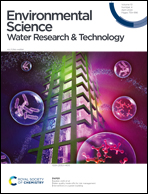Water quality trade-offs for risk management interventions in a green building†
Abstract
Premise plumbing water quality degradation has led to negative health impacts from pathogen outbreaks (e.g., Legionella pneumophila and non-tuberculous mycobacteria), as well as chronic effects from exposure to heavy metals or disinfection by-products (DBP). Common water quality management interventions include flushing, heat shock (thermal disinfection), supplemental disinfection (shock or super chlorination), and water heater temperature setpoint change. In this study, a Legionella pneumophila – colonized Leadership in Energy and Environmental Design (LEED) certified building was monitored to study health-relevant water quality changes before and after three controlled management interventions: (1) flushing at several points throughout the building; (2) changing the water heater set point; and (3) a combination of interventions (1) and (2) by flushing during a period of elevated water heater set point (incompletely performed due to operational issues). Microbial (culturable L. pneumophila, the L. pneumophila mip gene, and cATP) and physico-chemical (pH, temperature, conductivity, disinfectant residual, disinfection by-products (DBPs; total trihalomethanes, TTHM), and heavy metals) water quality parameters were monitored alongside building occupancy as approximated using Wi-Fi logins. Flushing alone resulted in a significant decrease in cATP and L. pneumophila concentrations (p = 0.018 and 0.019, respectively) and a significant increase in chlorine concentrations (p = 0.002) as well as iron and DBP levels (p = 0.002). Copper concentrations increased during the water heater temperature setpoint increase alone to 140 °F during December 2022 (p = 0.01). During the flushing and elevated temperature in parts of the building in February 2023, there was a significant increase in chlorine concentrations (p = 0.002) and iron (p = 0.002) but no significant decrease in L. pneumophila concentrations in the drinking water samples (p = 0.27). This study demonstrated the potential impacts of short-term or incompletely implemented interventions which in this case were not sufficient to holistically improve water quality. As implementing interventions is logistically- and time-intensive, more effective approaches are needed for informing preventative and corrective actions that are beneficial for multiple water quality and sustainability goals.

- This article is part of the themed collection: Protecting Our Water Collection


 Please wait while we load your content...
Please wait while we load your content...
